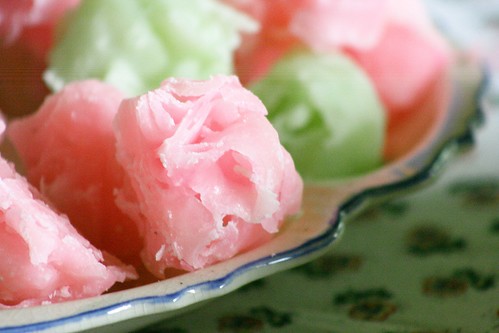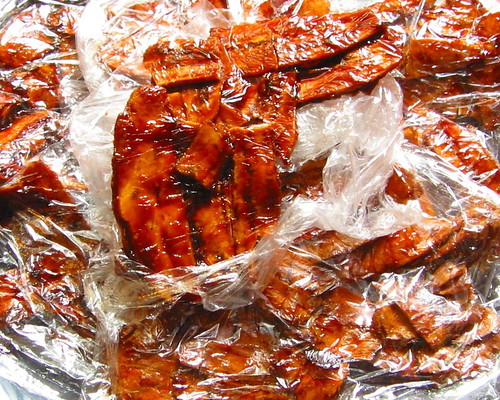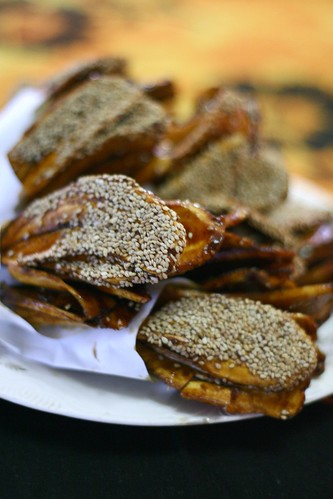Sugar rush in Cebu, part 2
My Sugar craving is not limited on Western food like pastries and cakes. I, too, am nuts of local Filipino delicacies, and let me start with homegrown candy fare.
Carcar’s bucarillo
There are bukayo (caramelized coconut strips) and there are bukayo. The special bukayo of the old town of Carcar, aptly called bucarillo, takes the prize as the best in the lot. Imagine wonderfully colored coconut strips caramelized in white sugar. Carcar has lots of bucarillo makers but unfortunately, most of the packs being sold in the local market are on the tough side. The best bucarillo can only be had by special order from the original bucarillo maker in the photocopy shop behind the Carcar City Hall. One piece is about P5 each, quite a sum versus the regular pack of six at P10 something sold publicly. But what a heady difference! Boasting of only the most tender slivers of young coconut (butong in Cebuano) tinted in the slightest shade of pink or green, this special bucarillo rolls and melts in your mouth. I only got to try this last November during Carcar’s fiesta and I still am trying to obtain the contact details of the maker. I will definitely publish the trail someday. 
Canon EOS 350D Digital, 1/200s, f/5.6, 230mm, ISO 800, -1/3EV
bucarillo, Carcar City, Cebu
phototip: A local town fiesta spread is not the best of settings but the pastel colors are begging to be captured. Use natural light and high ISO to get the right pastel softness (unless of course you are a strobe specialist which I am not).
Talisay’s consilva
Consilva are caramelized banana fritters that are razor-sliced and sinfully swathed in sticky caramel. Sold as candy fare in the beaches of Talisay (P5-6/pack) and ‘imported” to as far as Mactan, consilva is known for its simple plastic packaging which makes eating it a messy but memorable affair. The consilva is probably found only Cebu and sadly, a vanishing delicacy. I heard that it is prepared only by 4 remaining family enterprises in barangay Dumlog, Talisay.
Canon PowerShot S40, 1.61s, f/5.0, 7.1mm
consilva from Talisay City, Cebu
phototip: Consilva sticks on the thin plastic package like crazy. Since, plastic is both reflective and dull, simplify the shot by just filling the frame.
Masterline Bakeshop’s pinasugbo
The supple and elastic toffee of consilva is its main attraction but it lends to preservation issues hence only its drier cousin, the pinasugbo (literally, “made Cebu-style”), is available commercially in the grocery stores. In pinasugbo , the banana slices are thicker and they are wrapped at one end with white bond paper for handling convenience. Sesame seeds are often sprinkled on the banana as well. But being more desiccated, the pinasugbo often comes out hard and brittle and the banana slices cannot really be separated completely from the bond paper. Eating pulp with caramel is a given with pinasugbo.
I always thought that the best pinasugbo came from neighboring provinces like Negros Occidental (Bacolod) or Iloilo. Wrong! Last December, I discovered Masterline. It is an old bakeshop in Cebu primarily known for local biscuits like the otap and galletas but its pinasugbo is almost just like consilva in its soft caramel goodness, which also makes separating the banana from the paper wrap easy. Although priced at P80/plate of 12, each of the Masterline serving is 4 times the bulk of the ordinary commercial pinasugbo in the supermarket. I get my regular supply from the Masterline display center at St. Patric Square, Ramon Aboitiz St across the back lot of St. Theresa’s College. Masterline’s old store is in Don Gil Garcia St., Capitol Site.
Canon EOS 350D Digital, 1/40s, f/1.8, 50mm, ISO 800
Masterline Bakeshop pinasugbo, Cebu City
phototip: If you can, play with patterned fabrics. I used a black and orange batik wrap to highlight the brown-white contrast of the sesame-freckled banana candy.
My fervent love affair with sugar continues.






1 comment:
bucarillo, coined by combining 2 words. Bukayo & Aurillo... the person who made the first bucarillo... bukayo ni Aurillo... bucarillo.
Post a Comment